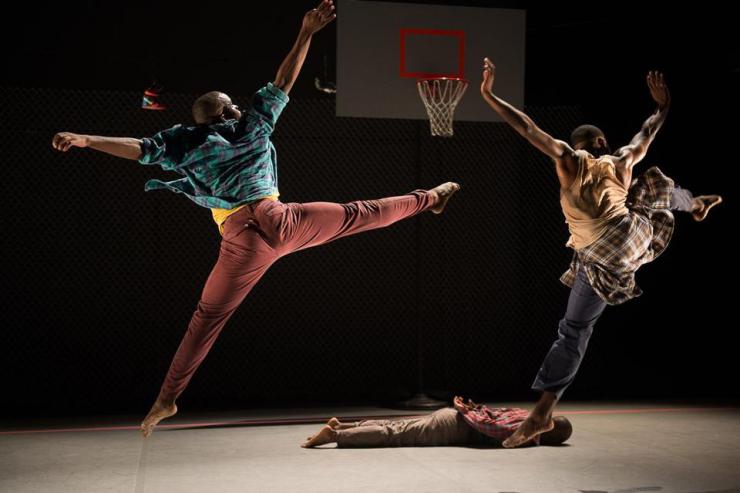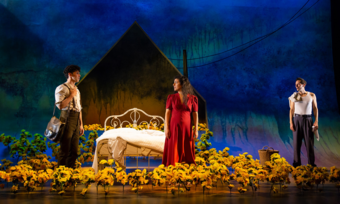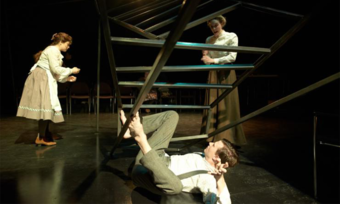A Dance of Desegregation at Jacob's Pillow
Even more than the other cultural encampments that dot Berkshire County, Massachusetts, Jacob's Pillow enchants. It is a green place that seems unreal, folded into the forest. If by some technicality it is not a glen, it ought to be. You must go by car, and driving there gives a constant sensation of having missed the turn, having gone too far. Always at last, purple banners snap from trees and you have found it. You make a turn. Someone in white waves you to the entrance, tells you where to leave the auto. And wonderingly in you go. The place is filled with lanterns and bright lights glowing out of clustered barns that are reached by winding little paths across green lawns, bordered by cattails and pine. All of the women are wearing diaphanous, colored things, walking through the woods in soft conversation. There are cups of coffee and glasses of wine, picnics of delicacies, and there are more and closer stars and crickets and spring peepers in the distance than one might have expected. A breath is caught at the very premise: we are walking through the forest to see a ballet.
Some suspension of disbelief is involved in magical places. At certain stages of childhood, we seem to understand it: there is no Santa Claus, the fairies are not real, etc. But another awakening, as painful, of this kind, must happen when we learn that even the places that are visible, when they are truly lovely like the Pillow, are built on money. If they are built to support the arts, much might rest on private money. And if they are set in the woods, among an audience willing to afford long vacations for frequent patronage, it is money indeed, and many faces you will see are white and crowned with silver. So to a certain glance it might seem to present a contextual irony—if not a problem—that when the summer season at Jacob's Pillow was announced this year it included an evening-long dance—an adaptation of the classic American film, Boyz N the Hood.
In July of this year, HowlRound's own Lily Janiak opened an important conversation about the sociological peculiarity of "elite" theaters, and the methods of artistic directors who wish to maintain an open sensibility to social issues in their programming. In her NewCrit piece on American Night at Cal Shakes, Janiak took note of the irony of a presentation about racial and economic inequality that played to a predominantly white audience. One of the broad takeaways from the review, if not its specific argument, is that these efforts can be somehow complicated due to a fairly homogeneous audience.
Many of her responders were awake to a certain tone of ironic clarity in Janiak's review, while some found in her response a lack of consideration for the delicate situation of artistic staff at a place like Cal Shakes: their problem is not holding a wolf by the ears, but convincing an audience to take a wolf by the ears for their own enjoyment. If there are some fits and starts involved in such a project, it might be suggested that they should be excused, because it ain't easy. So, one might recognize some irony or problem, but hesitate to recommend any corrective. What becomes most clear is that it is easier to become aflutter about the issue than to know quite the right way to respond.
Perhaps the best response is minimal, and offered by the artist. Kyle Abraham, the artistic director of Abraham.in.Motion, opens his program note for Pavement, the finale at the Jacob’s Pillow festival, on Pittsburgh’s segregated black neighborhoods, with a quotation from The Souls of Black Folk by W. E. B. Du Bois:
"Men call the shadow prejudice, and learnedly explain it as a natural defense of culture against barbarism, learning against ignorance, purity against crime, the 'higher' against the 'lower' races."
What are the results of thinking someone "higher," someone "lower"? These are touchy issues, but they are also metaphors of physiology and space, and dance is suited to take them up artfully and without didacticism. In the formal scheme of Pavement, the dancer who is higher in space might always take the lower position, and vice versa: lifts have been orchestrated by contact improvisation rather than gender or other roles. Here physics is the only limiting factor, and the limits it suggests are pushed. This strategy, apart from its interest as technique, has a dramaturgical dimension. Differences in the form of the dancers' bodies quickly come to be more significant handles for observation than the color of skin, and the prejudices we might want to assume about the roles of white dancers and black, male dancers and female, are not rewarded except by subversion.
Prejudice is not one of Abraham's vices, but one of his tools. Conflict is not presented in the language of superiority and inferiority, except when this can be complicated in a broader language of bodily relationship that has no hierarchy, so that neither race nor gender nor size is allowed to simplify a relation between performers, but only to complicate the way it might be read with a prejudicial eye. This is not confusing, but beautiful. If status is assumed in one configuration, it evaporates in the next.

Each dancer seems to be of a different type entirely, and quotidian movement and snips of dialogue accent this. Jae Neal is as fascinatingly different in movement from Maleek Washington as he is from Matthew Baker. Rena Butler, a woman, is very different from all three. One feels in each performer a complete and individuated relationship with the body that is visible even in unison: always each has identity, and no identity is subordinate, which is particularly remarkable with Kyle Abraham, the choreographer himself, taking the stage. But individuality does not interfere with the coherence of the company: difference defines the beauty and balance of the ensemble, and gives force of surprise and wonderful complication to the configurations that the company takes.
But if lifts can be defiant, surprising, and destabilizing of paradigm, the relationship with the floor—as the title Pavement might suggest—is darkly shaded, and deeply important to the work. The piece begins not with a lift but with a putting down: two dancers have entered the space, marked with a basketball hoop and a chain link fence, and have begun to dance to Mississippi Fred McDowell's "What's the Matter Now?": wild, juicy sequences with multiple reversals, isolated in close space, bearing some relationship to popping and locking with internal, isolated rhythm.
If status is assumed in one configuration, it evaporates in the next.
A third dancer enters. One at a time, he takes the dancers' hands behind their backs, as if in handcuffs, and lowers them like objects to the ground. The first two men are black. The third is white. In a moment, it is about race. But as elsewhere, a shift from this perspective is cinematically abrupt. If we notice the force of the image of being put down to the floor, we also notice when the dancers rise. Kyle Abraham does not rise, for a long period of time in the second half of the piece. Is he dead? Does his body seem to crumple as it stays on the floor while the others dance? Pairs of sneakers on clothesline are flown in to dangle over the chainlink. Eric Williams faces and circles the immobile Abraham; a cautious duet with the dead, both clinical and animal, electric with tension. Chalvar Monteiro leans against Abraham's body, his clear focus and childlike mannerisms suddenly poignant and uncanny, and eats a bag of Doritos while footage of the demolition of a twenty-story housing project in Pittsburgh's Hill District is projected like apocalypse on the backboard that floats above his head.
The dance is both shocking and elegant: its content reaches a synthesis with form that elevates both. Abraham has imagined a form that coherently includes walking, speech, violence, and all of the mannerisms a particular social life that these activities infer, together with the more stylized mannerisms that are forms in hip hop, jazz, and classical dance. Objects float in. Somebody steals the sneakers off of whoever is left immobile, facedown, on the floor. Gestures become shapes. Music shares sonic space with shouting, with pleas for help, and with dialogue about pork rinds and cough drops from the convenience store. The rich variety of material, and the rich variety of uses that Abraham finds for it, makes for a stark, empty contrast when the floor is used. It is legibly tragic, blank, chillingly reminiscent of crime scenes. As the piece closes, the dancers lie in stacks like cards, facedown, on the floor. Every so often, someone squeezes himself free. He gets up, but only long enough to put himself on top of the others, face down. It is a wrenching simplicity. The image could belong in Beckett.
But Pavement belongs in an enchanted place. It does away with the false division between social consciousness and formal beauty. Though the piece deals with issues that are political, though it has its darkness, and even though it was hosted in Becket, Massachusetts, our focus as an audience cannot be sociological by the end of the piece. Abraham's genius incorporates politics and problematics into a formal whole that is art, not a problematic social situation. As Abraham stood before a standing ovation with his company, thanking the directors and administrators of Jacob's Pillow who brought attention and funding to his early work, and made this mature work possible, something was clear. Money and influence can come together to make a true work of art happen. We all keep hoping for that moment. And, sometimes, it comes.







Comments
The article is just the start of the conversation—we want to know what you think about this subject, too! HowlRound is a space for knowledge-sharing, and we welcome spirited, thoughtful, and on-topic dialogue. Find our full comments policy here